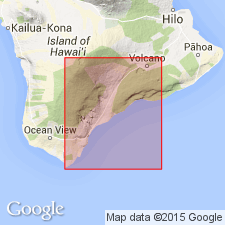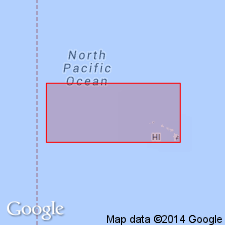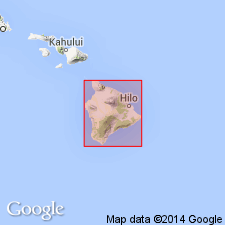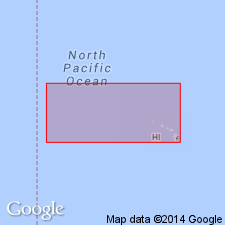
- Usage in publication:
-
- Glenwood ash
- Modifications:
-
- Original reference
- Dominant lithology:
-
- Ash
- AAPG geologic province:
-
- Hawaii
Summary:
Pg. 26, 27. Glenwood ash. Red clayey material (apparently weathered ash) about 10 feet thick; unstratified except for thin carbonaceous streaks. Correlated with Pahala ash. [Age is Pleistocene.]
[Type locality not designated.] Named for deposit on Hilo-Volcano road near Glenwood, Island of Hawaii, HI. Occurs on east slope of Mauna Loa near Glenwood, Ferndale, and Olaa, Island of Hawaii, HI.
Source: US geologic names lexicon (USGS Bull. 1200, p. 1529); GNU records (USGS DDS-6; Menlo GNULEX).

- Usage in publication:
-
- Glenwood tuff
- Modifications:
-
- Redescribed
- Areal extent
- Dominant lithology:
-
- Tuff
- AAPG geologic province:
-
- Hawaii
Summary:
Pgs. 55-56. Glenwood tuff. Two separate areas of Glenwood tuff probably total 25 sq mi. Maximum thickness is about 12 feet; is usually about 9 or 10 feet thick. Overlies Olaa agglomerate. Underlies Mauna Loa and Kilauea flows. On p. 35, author states "The yellow tuff deposits of Kalae, Kapukapu, Kilauea and Glenwood are considered to belong to the Pahala formation." [thus restricted]. Age is considered Pleistocene.
Source: US geologic names lexicon (USGS Bull. 1200, p. 1529); GNU records (USGS DDS-6; Menlo GNULEX).

- Usage in publication:
-
- Glenwood ash
- Modifications:
-
- Not used
- AAPG geologic province:
-
- Hawaii
Summary:
On p. 71-72, authors state "Mauna Kea was the source of the bulk of the ash [Pahala Ash], especially on Mauna Kea and the eastern slopes of Mauna Loa inland from Hilo, as shown by the thinning of the ash ... to 8 feet at Glenwood".
Source: Modified from GNU records (USGS DDS-6; Menlo GNULEX).

- Usage in publication:
-
- Glenwood tuff
- Modifications:
-
- Not used
- AAPG geologic province:
-
- Hawaii
Summary:
Pg. 83. Considered to be part of Pahala ash (citing Stearns and Macdonald, 1946). Consists of red-brown earthy laminated weathered volcanic ash, in places containing typical resin-colored palagonite, with dark humus layer near top. Age is Pleistocene.
Occurs on east slope of Mauna Loa near Glenwood, Ferndale, and Olaa.
Source: US geologic names lexicon (USGS Bull. 1200, p. 1529); GNU records (USGS DDS-6; Menlo GNULEX).
For more information, please contact Nancy Stamm, Geologic Names Committee Secretary.
Asterisk (*) indicates published by U.S. Geological Survey authors.
"No current usage" (†) implies that a name has been abandoned or has fallen into disuse. Former usage and, if known, replacement name given in parentheses ( ).
Slash (/) indicates name conflicts with nomenclatural guidelines (CSN, 1933; ACSN, 1961, 1970; NACSN, 1983, 2005, 2021). May be explained within brackets ([ ]).

